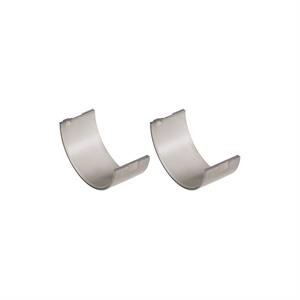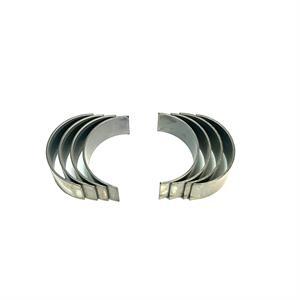Can You Replace Rod Bearings Without Pulling the Engine?

Rod bearings are a vital part of your engine but are also one of the most challenging parts to access. If your rod bearings are going bad and you want to spend less than hundreds or thousands of dollars on an engine replacement, it might be worth trying to replace them yourself.
This is not a do-it-yourself project with most industrial vehicles, although some people have successfully done it. However, one problem arises when trying to replace your rod bearings: they're buried deep inside the engine, and you must pull the engine out to get at them. If you're looking for more information on replacing rod bearings, we have an article that covers it here.
What Are Rod Bearings?
The rod bearings are located on the crankshaft and help support the connecting rods. They're made of metal and held in place by a bearing cap that fits over them like an oversized hat. Connecting rods transfer power from your pistons to turn your wheels. Your engine's ability to run smoothly depends on these bearings.
If you're experiencing problems with your vehicle's bearings, it can indicate a severe issue that needs to be addressed by a mechanic. For instance, if you're experiencing a loss of power or a grinding noise when you accelerate, one or more of your rod bearings will likely fail. If this happens, it could cause further damage to other parts of your engine.
What Do Rod Bearings Do?
The rod bearings are part of the crankshaft connected to the pistons. When the engine turns and spins, it pushes on those rods and causes them to move up and down inside their bores.
This movement is then transferred through these bearings so that it can be felt by your foot when you step on your gas pedal or depress your clutch pedal. This matters because if one of these rod bearings fails or breaks off completely, it could cause damage not only inside but also outside as well.
Can I Replace Rod Bearings Without Pulling My Engine Out?
You can replace rod bearings without pulling your engine out, but you must remove the oil pan to access them. Here are the steps to replace your rod bearing without pulling the engine out:
- Remove the oil pan: This requires removing all of the bolts that hold it onto the block and any hoses connected to it. Depending on your industrial vehicle type, you may also need to remove other things like brackets or sensors (and, therefore, how many different parts are attached).
- Remove crankcase cover: This requires removing all of its bolts and any hoses or brackets attached to it. This grants you access to the crankshaft and connecting rod bearings.
- Remove connecting rod caps: You can do this by removing their bolts or nuts (depending on what kind of vehicle you have). Be sure to keep these caps numbered or in order with the connecting rod you remove it from. It’s critical the caps are put back on the same rod they came off of.
- Inspect connecting rod bearings: Once you have removed the bolts or nuts, look inside each part and see if there is any damage or wear. If they are worn, it’s time to replace them with new ones. Depending on the severity of the damage you may need to remove the crankshaft. It’s good practice to measure your rod journals at this point to make sure they are within spec. If they are out of spec, the crankshaft will need to be removed and machined.
- Replace connecting rod bearings: Remove the bearing from the bearing cap and the upper part of the rod. Be sure to wipe down the surfaces to ensure nothing will be trapped under the new bearing once installed. After installing the new bearings, pull the rod back down to the journal and install the rod cap back on. After installed, torque the bolt/nut to the proper spec. In certain instances new bolts are required.
How Often Do I Need to Change My Rod Bearings?
Rod bearings are worn items and need to be replaced regularly. The frequency of rod bearing replacement depends on how much you use your vehicle, so there's no general rule for when they should be changed if you drive a lot; ably best to have them replaced every time the engine is rebuilt.
If you drive less (like if you use a forklift) or if your vehicle uses synthetic oil, replacing the rod bearings may only be necessary after 100k miles or more.
The frequency of replacement also depends on how well you maintain your vehicle. If you use synthetic oil, change it regularly, and perform other routine maintenance, it'll be longer before you need to replace the rod bearings. In some cases, people have been able to get 100k miles out of their engine before replacing the rod bearings.

FAQs
Can I Replace Just Rod Bearings?
You can replace just the bearings, but you'll need to buy an entire replacement assembly. Consider having someone do it for you if you're unfamiliar with engine repairs.
So, how much does replacing the bearings in an engine cost? If you have the bearings and seals replaced, expect to pay over $1,000. However, if you have a professional do it for you, you should spend approximately $2,000.
How Long Does It Take To Replace Rod Bearings?
How long it takes to replace rod bearings depends on the size of your engine and what type of parts you're replacing.
If you have a small engine, like one for a forklift, this job should take about an hour or two. It could take several days if you're working with something larger, like a Caterpillar engine.
The more complicated the job is (more parts involved) and the bigger/more expensive those parts are (like specialty bearings), the longer it will take to complete successfully.
Is It Worth Replacing Rod Bearings?
The rod bearings are cheap and easy to replace, so it's only worth pulling the engine if you have no other option.
Suppose your vehicle has a bad knock in one or more cylinders, and you suspect it might be related to worn-out rod bearings. In that case, it's best to take the vehicle in for a professional diagnosis before attempting any repairs yourself. The symptoms of worn-out rod bearings include:
- Knock or tapping noise at idle speed (when the engine is cold). This can be difficult to hear if your vehicle is well-insulated with sound-deadening materials.
- Low Oil Pressure can indicate excessive clearance in your engine's bearings.
- Unusual vibration in the steering wheel when driving at speed. This is often difficult to detect, particularly if your vehicle has a lot of power steering assist or has been modified with stiffer suspension components like coilovers.
If these problems are detected, it's time to take your vehicle in for a thorough inspection by a professional mechanic.
How Many Miles Do Rod Bearings Last?
It depends on the type of rod bearings you have. Some can last up to 500,000 miles, while others can last up to 100,000.
The type of rod bearings you have and how well they are maintained can also affect how long they last. You should always watch for signs that your rod bearings need to be replaced or repaired, like a knocking sound or vibration.
What Causes Rod Bearings to Go Out?
The leading cause of rod bearing failure is excessive wear. As the engine heats up, it expands and puts pressure on all parts in its vicinity. This includes the bearings, designed to absorb some of that pressure by developing as well. If you don't regularly change your oil and add synthetic lubricant (or if you do but don't change it often enough), then there will be more friction between moving parts than normal, leading to premature wear on both sides of a rod bearing over time.
If you leave your vehicle sitting for too long without starting it up once in a while, or if there's something wrong with how you drive, this can also cause overheating problems and lead directly to oil starvation scenarios where no amount of new motor oil will save your bearings from destruction.
What Happens When Rod Bearings Fail?
Rod bearings are the most common cause of rod failure. When the rod bearings fail, it can lead to a loss of oil pressure and catastrophic engine failure.
Knowing what happens when a rod bearing fails is essential to understand how the overall rod fails. If a rod bearing gets too hot, it will expand and press against its race (the part that holds it). This can cause scoring on both sides of the bearing, causing metal fatigue that leads to eventual failure.
Learn More About Rod Bearings at Heavy Duty Pros
Removing rod bearings is essential to the engine rebuild process because it prevents you from damaging your crankshaft journals if something goes wrong. If you’re looking to remove rod bearings, don’t worry. We have all the resources and parts you need here at Heavy Duty Pros. Our professionals have much experience working on trucks and other heavy vehicles, so we provide all the necessary equipment to complete the job with quality in mind!